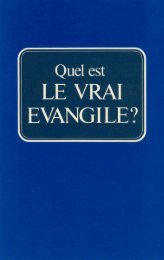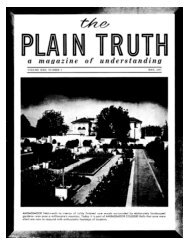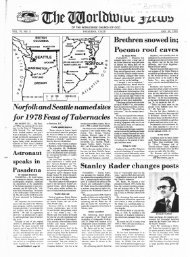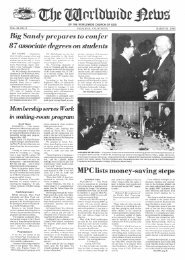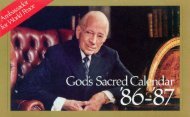The Biblical Basis of the Sacred Calendar Part One
The Biblical Basis of the Sacred Calendar Part One
The Biblical Basis of the Sacred Calendar Part One
Create successful ePaper yourself
Turn your PDF publications into a flip-book with our unique Google optimized e-Paper software.
predicted with accuracy until modern times), ancient man used mean values for <strong>the</strong> timing <strong>of</strong> <strong>the</strong><br />
conjunction <strong>of</strong> <strong>the</strong> sun and moon. All else being equal, <strong>the</strong>n, <strong>the</strong> first day <strong>of</strong> <strong>the</strong> calendrical month (rosh<br />
chodesh in Hebrew) should fall on <strong>the</strong> day <strong>of</strong> <strong>the</strong> mean conjunction or molad -- not on <strong>the</strong> day when <strong>the</strong><br />
new crescent appears. As we will see, this is exactly what <strong>the</strong> Bible implies.<br />
But <strong>the</strong> beginning <strong>of</strong> <strong>the</strong> lunar month is only one aspect <strong>of</strong> <strong>the</strong> "calendar question". Before we proceed<br />
fur<strong>the</strong>r, let us list <strong>the</strong> astronomical phenomena to which a calendar-maker might refer:<br />
1) <strong>The</strong> day-night cycle (which varies seasonally depending on one's latitude);<br />
2) <strong>The</strong> conjunctions and oppositions <strong>of</strong> <strong>the</strong> sun and moon;<br />
3) Solar and lunar eclipses (which are related to <strong>the</strong> above);<br />
4) <strong>The</strong> phases <strong>of</strong> <strong>the</strong> moon (in particular, <strong>the</strong> new crescent or phasis and <strong>the</strong> full moon);<br />
5) <strong>The</strong> rising and setting points and times <strong>of</strong> <strong>the</strong> moon on <strong>the</strong> horizon;<br />
6) <strong>The</strong> solstices and equinoxes <strong>of</strong> <strong>the</strong> solar year (which begin <strong>the</strong> seasons);<br />
7) Planetary conjunctions, oppositions, and elongations <strong>of</strong> position from <strong>the</strong> sun;<br />
8) <strong>The</strong> rising and setting points and times <strong>of</strong> certain "fixed stars";<br />
9) Transient phenomena such as comets, meteors, novae and supernovae.<br />
While <strong>the</strong> phenomena in category 9) have been observed and recorded by many peoples across history,<br />
by <strong>the</strong>ir very irregularity <strong>the</strong>y are <strong>of</strong> no use to <strong>the</strong> calendar-maker. Some ancient calendars do use some<br />
<strong>of</strong> <strong>the</strong> phenomena listed in category 7) - but never any form <strong>of</strong> <strong>the</strong> Hebrew sacred calendar.5 All <strong>of</strong> <strong>the</strong><br />
o<strong>the</strong>r phenomena were <strong>of</strong> keen interest to ancient man. Which <strong>of</strong> <strong>the</strong>se are <strong>the</strong> bases <strong>of</strong> <strong>the</strong> sacred<br />
calendar?<br />
"Signs...Appointed Times...Days...Years"<br />
Like <strong>the</strong> Sabbath itself, <strong>the</strong> astronomical principles behind <strong>the</strong> sacred calendar date to Creation Week.6<br />
<strong>The</strong>y are given in Genesis 1:3-4 and 1:14.<br />
Let us examine Genesis 1:14 first. "<strong>The</strong>n God said, 'Let <strong>the</strong>re be lights [<strong>the</strong> sun, moon and stars: 1:15-18]<br />
in <strong>the</strong> expanse <strong>of</strong> <strong>the</strong> heavens to divide <strong>the</strong> day from <strong>the</strong> night; and let <strong>the</strong>m be for signs and for<br />
appointed times, and for days and years...". This is a literal translation <strong>of</strong> <strong>the</strong> Hebrew Masoretic Text - <strong>the</strong><br />
very "oracles <strong>of</strong> God" as preserved by <strong>the</strong> Jews. This text even indicates <strong>the</strong> correct punctuation (through<br />
a series <strong>of</strong> "musical accents" accurately preserved but long misunderstood by Judaism).7<br />
This verse is written in priestly language,8 which means it has something to do with worship. Its terms are<br />
listed in <strong>the</strong>ir order <strong>of</strong> importance. <strong>The</strong> verbal grammar and <strong>the</strong> phrase structure (syntax) <strong>of</strong> <strong>the</strong> verse<br />
shows that "signs" and "appointed times" are connected, as are "days" and "years" in a different way. We<br />
know <strong>the</strong> motions <strong>of</strong> <strong>the</strong> sun in <strong>the</strong> sky determine <strong>the</strong> "days". What, <strong>the</strong>n, determines <strong>the</strong> "signs" and<br />
"appointed times"? Do "years" here refer to solar years (determined by <strong>the</strong> sun alone), or calendrical<br />
years (determined by both <strong>the</strong> moon and sun)?<br />
An Astronomical Hierarchy<br />
* "Signs" translates 'otot (<strong>the</strong> plural <strong>of</strong> 'ot). A "sign" not only marks something else as noteworthy; it is<br />
noteworthy <strong>of</strong> itself. <strong>The</strong> "signs <strong>of</strong> <strong>the</strong> heavens" caused superstitious fear among <strong>the</strong> pagans - as if <strong>the</strong><br />
phenomena were omens <strong>of</strong> present or coming events (Jeremiah 10:2). <strong>The</strong>se were extraordinary, yet<br />
obvious phenomena. Reasonably, <strong>the</strong>se "signs" were ei<strong>the</strong>r <strong>the</strong> same as or included <strong>the</strong> "signs"<br />
mentioned in Genesis 1:14, which are related to <strong>the</strong> motions <strong>of</strong> <strong>the</strong> sun and moon relative to each o<strong>the</strong>r<br />
and to <strong>the</strong> "fixed stars". Moreover, since Jeremiah 10:3-5 seems to refer to an early precursor <strong>of</strong> <strong>the</strong><br />
"Christmas tree" (a symbol connected with <strong>the</strong> "rebirth" <strong>of</strong> <strong>the</strong> sun at <strong>the</strong> winter solstice), it is reasonable<br />
that at least some <strong>of</strong> <strong>the</strong> "signs" in both passages relate to <strong>the</strong> solar seasons.




